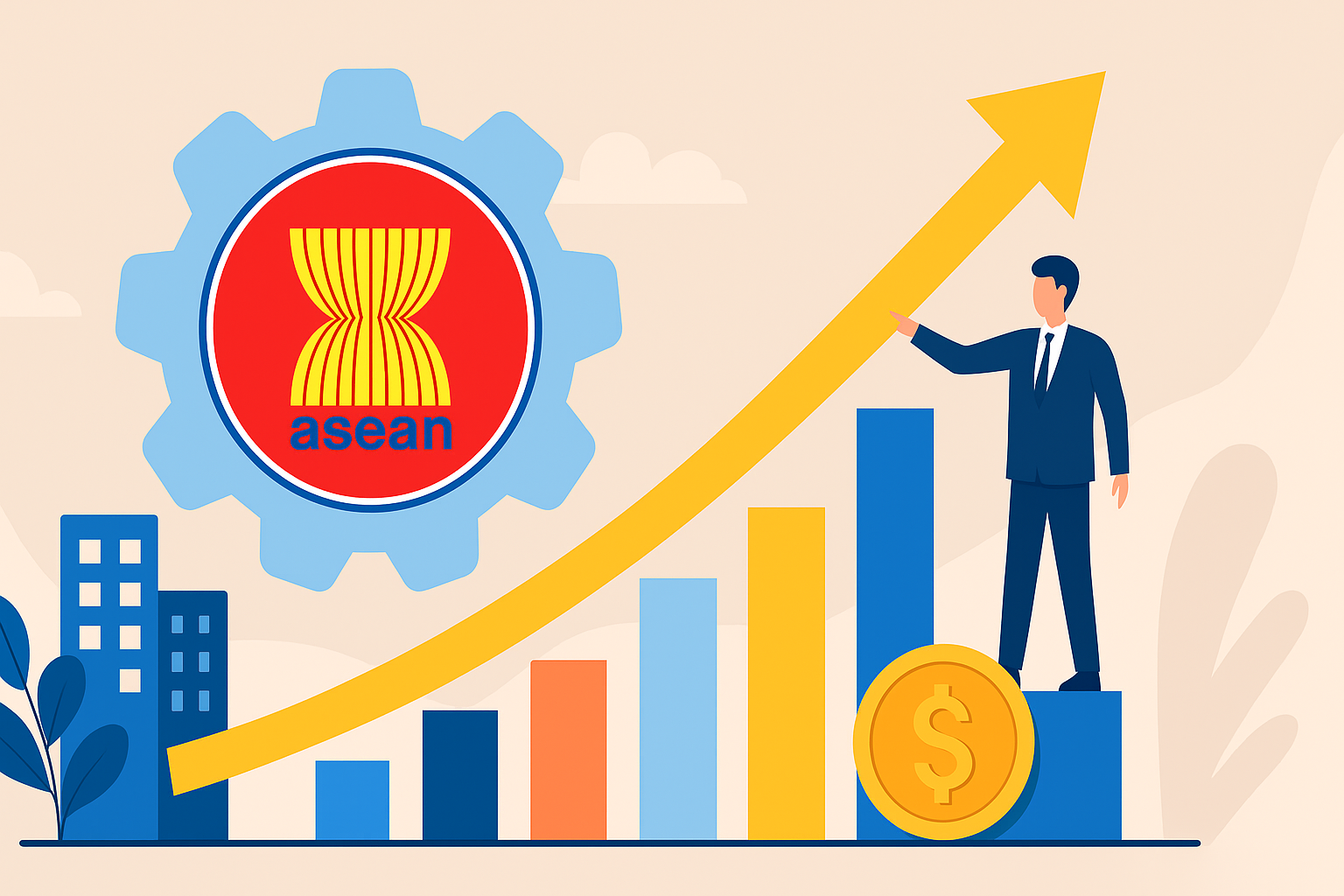Southeast Asia has officially entered the $4 trillion club. In 2025, the 10-member Association of Southeast Asian Nations (ASEAN) is projected to surpass $4.17 trillion in combined GDP, up from $3.95 trillion in 2024, a 5.6% year-on-year expansion driven by robust domestic demand, accelerating industrial transformation, and rising global investment flows into the region. This milestone cements ASEAN as the fifth-largest economic bloc in the world, trailing only the United States, China, the European Union, and Japan.
This is not a sudden breakout, but the culmination of a decade-long shift. While geopolitical tensions, supply-chain realignment, and the global race for digital competitiveness have reshaped the economic landscape, Southeast Asia has positioned itself as the world’s most dynamic emerging growth engine, balancing manufacturing strength, young demographics, and a rapidly digitalizing consumer base.
A Region Growing Faster Than the Global Economy
The IMF’s latest GDP projections show ASEAN outpacing global growth, with the region expanding by 5.6% in 2025, versus an estimated 3.2% global average. The data illustrates a region moving in sync, but with standout performers:
Malaysia leads the bloc with 11.4% growth, fueled by electronics exports, EV supply-chain integration, and strong private consumption. The Philippines (7.1%) and Thailand (6.1%) follow, driven by tourism revival, infrastructure spending, and resilient household spending. Vietnam (5.5%) and Singapore (4.9%) benefit from manufacturing recovery, digital economy acceleration, and financial services strength.
Indonesia, the region’s largest economy, posts steady 3.4% growth, in line with its structural trajectory, anchored by infrastructure investments, nickel downstreaming, and a growing middle class.
Only Myanmar contracts, reflective of political turmoil and currency instability.
The Global Shift Driving ASEAN's Rise
ASEAN’s ascent is tied to one of the most significant structural changes in world trade since the 1990s: the re-wiring of global supply chains. As multinational firms diversify away from over-concentration in China, Southeast Asia has emerged as a primary beneficiary. “China+1” is no longer a buzzword, it is a corporate imperative.
Key drivers behind ASEAN’s momentum:
1. Supply-Chain Diversification
Electronics, automotive, and semiconductor players are increasing their Southeast Asian footprint. Malaysia’s fast growth reflects this shift, gaining contracts in chip packaging and EV components. Vietnam, Thailand, and Indonesia are capturing manufacturing relocation, while Singapore anchors high-value tech and data-center investments.
2. Digital Economy Expansion
Southeast Asia’s digital economy is projected to surpass $300 billion in GMV by mid-decade, driven by fintech, e-commerce, cloud services, and AI adoption. Indonesia, the Philippines, and Singapore lead in digital infrastructure, while Vietnam and Malaysia are scaling AI and cybersecurity talent pipelines.
3. Demographic Advantage
With a young population of over 680 million people and a rising middle class, ASEAN has one of the world’s fastest-growing consumer markets. The Philippines and Vietnam are notable consumption powerhouses, while Indonesia hosts one of the world’s most rapidly expanding urban populations.
4. Investment Magnetism
FDI inflows continue accelerating as global firms seek stability and growth. Singapore remains the regional investment hub, while Vietnam and Malaysia attract manufacturing capital, and Indonesia draws resource-based industrial FDI tied to minerals and batteries.
5. Tourism Revival
Thailand, Cambodia, and the Philippines benefit from surging tourism — with regional travel rebounding sharply and China gradually reopening outbound flows.
A More Mature Growth Model
Unlike past cycles driven heavily by export booms, today’s ASEAN growth is broader and more balanced:
- Domestic consumption is now a major economic pillar
- Governments are investing in digital infrastructure and green transition
- Manufacturing is shifting up the value chain
- Banking and fintech ecosystems are deepening
- Renewable energy, EV battery supply chains, and logistics are accelerating
This transformation signals that ASEAN’s growth is not just cyclical, it is structural.
The Challenges Still Ahead
The path to sustained momentum is not guaranteed. ASEAN faces:
- Global trade tensions affecting export-led economies
- Slower China recovery, impacting tourism and supply-chain flows
- Energy and food price volatility
- Political uncertainty in select markets
- Uneven digital adoption and infrastructure gaps
- Talent competition as AI and advanced manufacturing scale
Additionally, Myanmar’s continued instability and Brunei’s oil dependence illustrate the region’s uneven economic landscape.
But the macro picture remains clear: compared to other emerging markets, ASEAN displays a blend of resilience, diversification, and demographic strength few regions can match.
The Opportunity for Businesses & Investors
For companies and investors, ASEAN is not a frontier market anymore, it is a core growth engine.
Where opportunities accelerate:
- Manufacturing & supply-chain hubs (Vietnam, Malaysia, Thailand)
- Digital infrastructure & AI centers (Singapore, Indonesia)
- EV supply chain & battery minerals (Indonesia, Malaysia, Thailand)
- Consumer & retail expansion (Philippines, Vietnam, Indonesia)
- Tourism & hospitality revival (Thailand, Cambodia)
For global corporates, ASEAN offers diversification away from geopolitical risk. For startups and fintech players, it presents one of the most fertile digital adoption environments globally. For investors, the growth profile rivals India, but with a more diversified multi-market base.
A Quiet Giant Steps Forward
ASEAN’s $4 trillion moment isn’t just a symbolic threshold, it marks the region’s arrival as a foundational pillar of the global economy. Where once the bloc was viewed as an emerging-market cluster, it is now a central axis of global growth, innovation, and supply-chain strategy.
The next decade will test ASEAN’s resilience, but if current momentum continues, Southeast Asia is poised not just to participate in the global economy, but to shape it.
Data Sources:
- IMF World Economic Outlook Dataset, October 2025
- ASEAN Secretariat Macroeconomic Statistics
- National statistics offices (Indonesia, Malaysia, Singapore, Philippines, Vietnam)
- Regional central bank releases and trade agencies







 Thursday, 30-10-25
Thursday, 30-10-25







